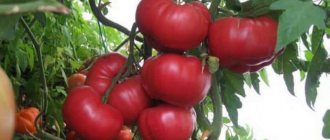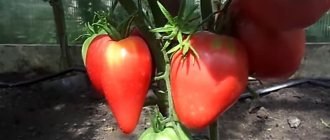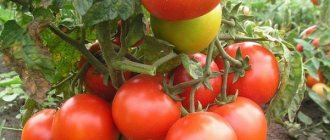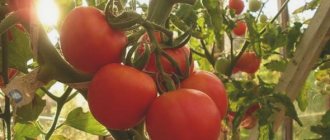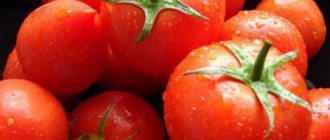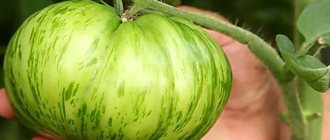In the list of exotic tomatoes that agricultural experts recommend trying, Indigo Rose occupies the top place. Black tomatoes are record holders for anthocyanins and antioxidants. They have a delicious, delicious taste and are extremely healthy.
| Height | Landing location | Ripening time | Fruit color | Fruit size | Origin | Fruit shape |
| Medium height | Greenhouse, Open ground | Mid-season | Purple | Average | Variety | Round |
Description of Indigo tomato
The description of the Indigo Rose tomato variety indicates that it belongs to the group of hybrid tomatoes.
It was developed by American breeders in 2015 by crossing an indigo-colored cultivated variety and wild varieties of tomatoes. This tomato variety belongs to the deterministic type. The bushes reach a height of up to 120-150 cm. In greenhouses, plants can grow up to 2 m. In open ground, as a rule, tomatoes reach 1 m. It is recommended to grow bushes with two trunks and a mandatory garter.
They grow mainly in height, with little foliage. The leaves are very bright green with pronounced membranes. A distinctive feature of the variety is the curling of the leaves.
Flowers are pollinated openly. The Indigo Rose tomato is a mid-season variety. Fruit ripening occurs approximately 100-110 days after planting the seeds.
Description of fruits
Indigo Rose fruits ripen on long branches of 6-8 pieces. They are not large in size; on average, one tomato weighs about 60 g. The shape of the fruit is round with a slight flatness at the base.
At the beginning of growth, tomatoes do not differ from other varieties and are green in color. As they mature, they begin to change color and become dark purple or even black. This color is given to them by the substance anthocyanin. It is also found in beets, blueberries and black currants.
The skin is very thin and smooth. The pulp of the fruit is fleshy and juicy. Inside, the fruits do not differ from other varieties and are red in color. The taste of Indigo Rose tomatoes is very rich, noticeably different from other varieties.
Important! Black tomatoes have a special combination of sugar and acids, which makes their taste special.
Characteristics and description
The Indigo Rose tomato variety was developed quite recently. In 2015, American University of Oregon horticulture professor Jim Myers crossed purple-colored cultivated varieties with representatives of wild tomato flora native to the Galapagos Islands and Chile. The result was an amazing black-colored variety.
Its features:
- The ripening period is early, the first fruits can be tasted after 100 days, and in hot summers even a little earlier;
- the Indigo Rose tomato variety can be grown in open ground, where it grows up to 1 m, and in a greenhouse, where its height is somewhat greater; according to gardeners, it can grow up to one and a half meters;
- The bush is not very leafy, the leaves are of the usual type. Sometimes they can curl - this is a feature of the variety;
- Tomato variety Indigo Rose forms a simple cluster, the number of fruits in it is from 6 to 8;
- the color of the skin is black, but not always: if the fruit is covered with leaves from the sun, part of it remains pink - hence its name;
- the skin is quite dense, which makes it possible to use Indigo rose tomatoes not only in salads, but also in marinades and pickles;
- tomatoes of this variety store well, their taste is interesting, very rich, the inside of the fruit is red;
- Indigo rose tomatoes have a very strong aroma that can be felt several meters away;
- the size of the fruits greatly depends on the care; most manufacturers position it as a cocktail variety, but reviews from gardeners say that the fruits can be larger - up to 100 g;
- The originator of the variety claims that the plants of this tomato can withstand frosts down to -5 degrees, but reviews from gardeners on this matter are mixed.
To give a complete description and description of the Indigo Rose tomato variety, it must be said that it is characterized by increased resistance to late blight.
Until recently, Indigo Rose tomato seeds could only be found among collectors. Now they are distributed by Biotechnika.
The yield of this variety is average, but it is valued not for that, but for the excellent dessert taste of the fruit.
Description and characteristics of the tomato variety Indigo Rose, reviews, photos
Late, cluster variety from a series of black tomatoes.
The bush, when grown in a greenhouse, reaches a height of up to 1.5 meters, more often up to 1.2 meters. In open ground up to 1 meter. In the OG it is recommended to grow only in the southern regions, otherwise the tomatoes do not have time to ripen. It is best to form a plant with 1-2 stems.
Basic qualities of fruits
photo author Maria Spirts
Ripe tomatoes are blue-black in color and grow in small clusters. The weight of tomatoes is 30-70 grams, the taste of ripe fruits is good, sweet, the flesh is red-pink, there are a lot of seeds. The skin is thin, so these tomatoes are not very suitable for canning.
The Indigo Rose variety is resistant to late blight.
In other catalogs this variety may be called Indigo , Indigo Rose .
This is a natural variety of tomato. Therefore, we recommend taking seeds from a ripe fruit and growing them again next season!
Reviews from those who grew this tomato are very ambiguous - the advantages include mainly an exotic appearance and good resistance to late blight, and the disadvantages include very late ripening and mediocre taste.
Features of the variety
Tomatoes are a mid-early, determinate, tall-growing type of tomato. The height of an adult plant ranges from 1.3 to 1.6 meters; sometimes tomatoes are found almost two meters high. In open soil, the height of an adult plant does not exceed 1 meter. The bushes are sparsely leafed, compact and grow in height rather than in width.
The leaf blades are colored rich green. The leaves are small in size and have pronounced membranes. It is recommended to grow tomatoes with 1-2 stems. Dense planting makes maintenance difficult and can also lead to the emergence of bacteria and bacteria of infectious etiology in the soil. Experts recommend growing tomatoes in the southern regions of the country. As the plants grow, the bushes must be pinched and tied to a strong support.
Characteristics of tomato
Despite the fact that this tomato hybrid was developed relatively recently, it has already gained popularity among gardeners. In addition to the beautiful and unusual color, this variety has other distinctive characteristics.
Productivity and fruiting
The description of the Indigo Rose tomato variety indicates that it belongs to the mid-season varieties. On average, ripening occurs approximately 3-4 months after planting.
Important! It is recommended to harvest tomatoes only when they are as dark in color as possible and soft to the touch.
This tomato variety is characterized by high yield. From 1 bush you can get up to 7-8 kg of tomatoes, and from 1 sq. m yield can reach up to 20 kg.
Indigo Rose can be grown in any region of the country. In the southern regions - in open ground, and in northern latitudes - in greenhouse conditions. The productivity of tomatoes depends mainly on light and heat. When grown in greenhouses, if planted early, the fruits will ripen earlier and be larger. In open ground conditions, the size of tomatoes will be smaller.
The creator of the hybrid claims that this variety has frost-resistant properties and can withstand frosts down to -5 °C.
Area of application of fruits
Thanks to its unique taste, Indigo Rose tomatoes are ideal for salads and fresh consumption. In addition, they can be used to make preserves; they retain their shape perfectly.
Anthocyanin will give tomatoes an immunostimulating and bactericidal effect. Good for weight loss.
Resistance to diseases and pests
The hybrid origin of the variety provided it with a high level of resistance to various diseases. In particular, this tomato is not infected with gray rot, fusarium and blossom end rot. The Indigo Rose tomato has high resistance to late blight.
Advantages and disadvantages of the variety
Like any variety of tomatoes, Indigo Rose tomatoes have their advantages and disadvantages. It is they who give all varieties their special characteristics and ensure the preference of gardeners.
Among the advantages of the variety are:
- High level of productivity.
- Unusual color and bright taste.
- Benefits from use.
- Easy to care for.
- Frost resistance.
The disadvantages of Indigo Rose are:
- Long ripening period.
- Short shelf life when fresh.
- The need for pinching and proper formation of bushes.
Wild Rose tomatoes: variety description
| Variety name | Wild Rose |
| general description | Mid-season indeterminate variety |
| Originator | Russia |
| Ripening period | 110-115 days |
| Form | Flat-rounded |
| Color | Pink |
| Average weight of tomatoes | 300-350 grams |
| Application | Table variety |
| Productivity of the variety | 6 kg per square meter |
| Features of cultivation | Standard agricultural technology |
| Disease resistance | Quite disease resistant |
The variety is of Russian origin, bred in 1999 and intended for cultivation in open ground and film greenhouses. Undemanding, tolerates temperature fluctuations calmly. The collected fruits are well stored and transported. Tomatoes can be harvested in the technological ripeness phase; they ripen successfully at home.
Wild Rose is a mid-early, high-yielding variety. Fruiting occurs 110-115 days after sowing the seeds. The bush is indeterminate, reaches 2 m in height and requires mandatory tying. Forms an abundant green mass and requires pinching.
The yield is quite high, from 1 sq. m you can collect up to 6 kg of tomatoes.
Among the main advantages of the variety:
- high taste qualities of fruits;
- good yield;
- unpretentiousness, resistance to heat;
- It is possible to grow Wild Rose tomatoes in greenhouses and in open ground.
The main difficulty when growing is a very tall bush that needs to be tied to stakes or trellises.
You can compare the yield of this variety with others in the table:
| Variety name | Productivity |
| Wild Rose | 6 kg per square meter |
| American ribbed | 5.5 per bush |
| De Barao the Giant | 20-22 kg per bush |
| King of the market | 10-12 kg per square meter |
| Kostroma | 4.5-5 kg per bush |
| Summer resident | 4 kg per bush |
| Honey Heart | 8.5 kg per square meter |
| Banana Red | 3 kg per bush |
| Golden Jubilee | 15-20 kg per square meter |
| Diva | 8 kg per bush |
Characteristics of the tomato variety Indigo Rose
The Indigo tomato hybrid is a mid-season universal variety. Since the plant’s ancestors came from the south, the tomato is not frost-resistant. Experts note the high yield and resistance to various fungal diseases of this variety. This is an open pollinated variety. The growing season from the moment of germination to the collection of the first fruits is 75 days. The height of the bushes reaches 1 meter, but in a greenhouse you can grow giant Indigo tomatoes of two meters in height.
Description of bushes and fruits
The plant is not rich in foliage; it grows tall and does not bush. The leaves on the tomatoes are bright green and medium in size. The variety is recommended for cultivation in open ground in the south, and in greenhouses in any region of the Russian Federation.
Tomato Indigo rose
The fruits at the moment of full ripening are not very large, round, dark purple or black in color with pink flesh inside. An average tomato weighs 50-65 grams. Tomatoes are fleshy, aromatic and sweet in taste. One cluster can bear and grow from 7 to 12 fruits. And although they are not entirely suitable for pickling, you can make excellent salads and sauces from these tomatoes and simply enjoy their taste when eaten raw.
It is important! It is better to harvest grown tomatoes when they are fully ripe, that is, they have acquired a rich dark color and become soft. They must ripen on the bush. At this point they will taste sweet.
Technology for growing Tomato "Indigo Rose" for beginners and experienced farmers
Thanks to its bright appearance and interesting taste, the Indigo Rose tomato has won the love of many fans. However, some are scared that the fruits of this variety are almost black, mistakenly considering them unnatural and harmful.
Experts are in a hurry to reassure: this type of tomato is bred exclusively in a natural way. Moreover, the Indigo rose tomato, the characteristics and description of which variety will be presented below, has unique beneficial properties.
Description of the variety
The main distinguishing feature of Indigo rose is the dark color of the fruit, which can range from dark purple to blue. There are also several similar varieties of tomatoes, with blue, purple and dark purple colors predominating.
Indigo apple
The Indigo Apple tomato is one of the varieties with a predominant dark color. The plant has fairly large fruits, weighing up to 150 grams. In terms of the method of cultivation and care, it is practically no different from Indigo rose.
The only difference is that the fruit is not completely black, but only at the base. Depending on the exposure to sunlight during the ripening period, the black color may predominate or be less pronounced.
Distinctive features
Among the features of the Indigo Rose tomato are:
- early ripening;
- bush resistance to diseases;
- the ability to grow both in a greenhouse and in open ground.
Fruit characteristics, yield
The Indigo Rose tomato bush forms a cluster of 6–8 tomatoes.
The thick skin of the Indigo Rose tomato fruit allows you to prepare them for the winter. The tomatoes are red inside and have a distinct spicy aroma.
Growing rules
The Indigo Rose tomato variety does not require much effort in biotechnology. High-quality seeds will help you grow a good harvest. But compliance with some rules is still necessary.
Planting seedlings
Seeds play a big role in the quality of the future harvest. They should be purchased from trusted manufacturers. Even the best seeds should be soaked in water before sowing. After the sprouts swell and peck, they are treated with potassium permanganate or a growth stimulator.
It is better to buy ready-made soil for tomatoes or make it yourself. It should be soft and loose. The soil is poured into the prepared container. You can sow the seeds in a common large container or directly into individual cups.
Seeds are planted at a depth of approximately 1 cm and at a distance of 10 cm from each other. Afterwards, the seeds are sprinkled with soil and watered using a shallow watering can or spray bottle. Watering is done daily until sprouts appear.
After the first shoots, containers with seedlings are transferred to a sunny place. It is important to monitor the air temperature in the room and avoid large changes. The optimal range is from + 18 °C to + 22 °C.
After 4 leaves appear, the seedlings need to be pruned. Transplantation is carried out into individual cups. Dividing the bushes must be done carefully so as not to damage the root system.
Fertilizing during the growth period of seedlings is carried out 2 times - after the appearance of the 2nd leaf and after diving. Fertilizers are applied with a weak solution and carefully under the roots.
Tomato transplant
Indigo Rose tomato seedlings are ready for planting in a permanent place 50 days after sowing the seeds. By this time, the bushes reach a height of 25 cm. But the exact timing depends on the ambient temperature. In the southern regions it is possible to plant as early as mid-May, and in the northern regions only at the beginning of June. Also, the timing of planting depends on the growing method - you can transplant it into the greenhouse earlier.
For ease of care and harvesting, it is recommended to adhere to the standard pattern when planting tomatoes - about 40 cm between bushes and at least 70 cm between rows. In addition, such planting provides a sufficient amount of air and freedom of growth for the bushes.
Subsequent care for tomatoes
After planting seedlings, caring for Indigo Rose tomatoes is not much different from many other varieties.
This type of tomato is not a moisture-loving plant. It tolerates lack of moisture well. Watering can be done once a week. It is better to do this with warm water.
Feeding plays an important role. They help the plant grow stronger and accelerate ripening. The first feeding is carried out after planting the seedlings, the subsequent ones once a month. It is recommended to use complex fertilizers. It is very good to add ash as a source of calcium.
The most important care can be called stepsoning. This variety of tomatoes requires the formation of a bush with one or two trunks. The remaining stepsons are removed.
The bushes are quite tall and have long branches, so they require a mandatory garter. Otherwise, they will simply break under the weight.
Agricultural technology for growing the variety
Breeders are still debating whether the acquisition of such an unusual color benefited the plants. Among some of them there is an opinion about the low germination of seeds of this variety, slow growth, long ripening period and poor resistance to diseases, although reviews from gardeners often say the opposite.
Advice! To find out the truth, the easiest way is to plant Indigo rose tomatoes in your garden and test everything experimentally.
But first you have to grow seedlings.
Growing seedlings of these tomatoes has no special features.
- We prepare the seeds: we treat them with a disinfectant - potassium permanganate at a concentration of 1% or a solution of phytosporin. In order not to worry about seedlings, it is best to germinate the seeds of the Indigo Rose variety of tomatoes. We do this after soaking in a growth stimulator, which we carry out according to the instructions for the selected drug.
- Germination is best done in damp cotton pads. For successful germination, greenhouse conditions are needed: constant high temperature and high humidity.
- We sow the sprouted seeds into the soil for tomatoes and keep them warm until germination, not allowing the soil to dry out. To prevent plants from wasting time adapting after picking, it is better to plant them immediately in separate cups.
- Hatching loops are a signal that the seedlings need light. We move them to the brightest place so that the seedlings do not stretch out.
- We keep the seedlings at a temperature of 18 degrees at night and about 22 degrees during the day.
- Watering is needed infrequently, but sufficiently so that the soil in the pot is completely wet.
- For better growth, we feed the sprouts 2 times with a weak solution of mineral fertilizers: in the phase of 2-3 true leaves and after another 2 weeks.
Care after disembarkation
The planting pattern for this variety is usual: 40-50x60 cm. Further care is as follows.
- Watering. The Indigo rose tomato is considered a drought-resistant variety, so watering it once a week with warm water is quite enough. But this is subject to mulching the soil with organic materials.
- Feeding. They are standard: the first one is planted 2 weeks after the seedlings take root, the subsequent ones - once every ten days. They use complete mineral fertilizer, adding ash to it during the fruiting period as a source of potassium. No blossom end rot disease was observed on tomatoes of this variety, but on sandy loam and sandy soils it is better to apply a single fertilizing with calcium nitrate at the moment of ovary formation on the second cluster. Spraying with a solution of boric acid at the time of flowering of tomatoes will help increase the yield. They are carried out 2 times.
- Formation. Both in the open ground and in the greenhouse, the Indigo Rose tomato variety needs pinching and staking. In the south, you can remove the stepsons up to the first cluster; to the north, the tomato is formed into 2 stems, removing all the other stepsons.
A few words about harvesting. Indigo rose tomatoes become fully ripe when they have acquired the characteristic color of this variety and become slightly soft. Many gardeners pick tomatoes before they are fully ripe and are disappointed with the taste.
If you want not only to eat a delicious vegetable, but also to be treated with it, the Indigo Rose tomato variety is the best choice.
During the growing season, the soil is loosened and bushes are hilled. When applying fertilizing, the condition of the soil and the appearance of the plants are taken into account. At each stage of growth, the qualitative and quantitative composition of fertilizers is regulated.
To prevent the surface layer of soil from drying out and distribute moisture evenly, mulching is carried out. For this purpose, black non-woven fiber is used. The use of organic materials (straw, leaves, grass) as mulch serves as a source of organic nutrition for plants.
Features of cultivation and care
The Indigo Rose tomato is a completely unpretentious plant, but the gardener needs to take note of some points:
- After swelling of the soaked seeds, it is necessary to keep them in a strong solution of potassium permanganate for up to half an hour, then they are washed and dried.
- Tomatoes are planted in a soft, warm substrate at a distance of 10 cm from each other in grooves up to 1 cm deep. Cover with soil sifted through a sieve.
- The first watering is from a spray bottle, then you can use a regular watering can. The frequency of watering is daily until sprouts appear.
- As the seedlings grow, you should pour the substrate two or three times between the rows and remove weak and painful sprouts.
- Indigo Rose tomato should be fed if the seedlings are not yet strong enough by the day of transplantation.
- Planting is done when there is no threat of frost on the soil. Row spacing is from 70 to 100 cm, depending on the size of the bushes. In one row, plants are planted every 30-50 cm.
- Try to protect tomatoes from high and low temperatures, water, fertilize, and remove shoots in a timely manner. Do not forget to mulch the soil around the roots with pine needles or wood chips.
Pest and disease control
Indigo Rose tomatoes are highly resistant to various diseases. Despite this, when growing tomatoes it is necessary to carry out preventive treatments.
All plants and pests quickly get used to one type of drug. Therefore, it is recommended to alternate treatments with different means.
The most effective means for processing tomatoes:
- Fitosporin;
- Copper preparations;
- Ridomil;
- Quadris.
In addition to processing, it is necessary to check the bushes for diseases and pests and immediately pick off the affected leaves. This will help to detect the disease in a timely manner and prevent its spread.
Purple (dark) tomatoes
The selection of dark-skinned tomatoes dates back to the sixties of the last century. Bulgarian scientists crossed wild varieties of tomatoes from Chile and the Galapagos Islands with local dark varieties (Black Prince). However, in those days, the newly developed varieties were not widely used.
Nowadays, when researchers have determined that the blue or purple color of such tomatoes is a sign of the high content of natural antioxidants anthicyanins in the vegetable, purple varieties are gaining more and more popularity. Tomato Indigo Rose (reviews, photos of it you will see below) is the darkest of them. In addition to it, the following blue tomatoes are also popular:
- Original color.
- Blue Gold.
- Blueberry.
- Dance with the Smurfs.
- Dark Galaxy.
- Red coal.
- Stripes of the past.
- P20 Blue.
- Blot.
- Blue-green zebra.
- Wild cherry.
- Amethyst.
- Amethyst Cream Cherry.
- Blue chocolate.
- Fire Blue.
- Cherry Blueberry.
- Blue beauty.
- A real gem.
In addition to excellent taste, dark fruits have the following beneficial properties:
- Reducing the risk of vascular diseases.
- Counteracting the formation of cancer cells.
- Strengthening the walls of blood vessels.
- Improved visual acuity.
Many botanists believe that the first tomatoes brought to Europe were of this particular shade. They explain this by the fact that in the plant’s homeland, South America, most wild varieties of tomatoes have purple fruits.
What is this variety?
Since this unique variety is interesting precisely because of the unique coloring of the fruits, we will begin the description of the variety with the characteristics of the vegetable itself. The vegetable is “overseas”, just like its name. We'll just call him Rose.
The fruit itself is a round-shaped vegetable, at the beginning of its formation it is green in color (like ordinary tomatoes); as it ripens, it acquires a rich blue-violet color, which approaches black. Inside, the fruit has a bright scarlet color, characteristic of all its other relatives. The weight of the fruit reaches 40-50 grams, all the vegetables on the bushes are uniform, approximately the same in size, the color can vary from uniformly blue to blue-red (the tip of the fruit is red).
The vegetable tastes sweet, has a fairly dense consistency, tolerates transportation well due to its neat and uniform size of the fruit, and has a very marketable and respectable appearance.
It is important to know! The advantage of this variety is its increased resistance to such a common disease as gray rot. This variety belongs to determinate plants, the growth of which is limited. It grows well indoors and on balconies; special containers are used for this. This method of growing has excellent decorative properties and you will always have on hand not only a healthy and tasty vegetable, but also a wonderful and unique decoration for your home or apartment.
To create this variety, breeders used the blueberry gene and the snapdragon gene. Thanks to this combination of genes, the innovative variety is very resistant to late blight.
Reviews indicate that this tomato was not even infected with late blight from a sick relative of a different variety. This is a very rare quality for all currently existing tomato varieties.
The characteristics of this tomato would not be complete without a description of all its advantages. These include:
- High yield.
- Decorative and exotic.
- Resistance to all diseases.
- Excellent transportability.
- Benefits for the body in the fight against extra pounds.
- Hypoallergenic.
- Great taste.
- Easy to grow and care for.
- Rose tends to withstand temperature changes.
- Good frost resistance. Withstands frosts down to minus 5 degrees.
Among the disadvantages of this variety, one can note the relatively late ripening period, short shelf life of the fruit, as well as the need for proper formation of the bush.
These tomatoes can be harvested 80-100 days after planting.
Description of the Indigo Rose variety
Tomato Indigo Rose (“indigo rose”) is a mid-season universal variety. The fruits are suitable for consumption both fresh and for preservation. The tomatoes are sweet, fleshy, dense, smooth, dark purple in color, weighing up to 60 g. The best time to harvest is when the color of the fruit reaches a rich dark shade and becomes soft to the touch. Since the Indigo Rose tomato does not taste too sweet and has a pleasant tart flavor, it is well suited for salads and frying.
Vegetative period of time from the moment of emergence of seedlings to ripening: 75 days. Medium-sized bush - up to 1 meter high. The plant is disease-resistant and high-yielding, open-pollinated, suitable for planting both in greenhouses and in beds.
Black tomatoes were bred in Oregon (USA), in the laboratory of Professor D. Myers. According to the scientist himself, Indigo Rose is the first improved tomato variety containing anthocyanin. Since this is the darkest type of tomato, it therefore has the highest antioxidant level. It was the result of crossing purple tomatoes with the usual red varieties. It is believed that the antioxidant contained in Indigo Rose helps in the fight against obesity, diabetes, and generally improves human well-being.
Features of cultivation
Sowing
Barberry Thunberg Rose Glow
To grow a rich harvest of Indigo tomatoes, you need to buy high-quality seeds and prepare them. Although this variety is not capricious and unpretentious, there are rules of agricultural technology that should not be neglected:
- firstly, you need to soak the seeds for two days in warm water;
- secondly, after this procedure it is good to dry it and soak it again for 30 minutes in a 1% manganese solution;
- thirdly, sow in small containers (pots or plastic cups);
- fourthly, sprinkle the seeds with thermally treated soil;
- fifthly, first water the seedlings from a spray bottle with warm water, do this daily.
It is important to know! During the growing process, seedlings do not need to be fed. But if at the time of planting in the ground the plant has not grown 25 centimeters, it should be fertilized.
Transplantation into the ground
It is possible to plant young bushes in open ground only when the weather is consistently warm. Tomato seedlings are placed in prepared trenches at a distance of 65 centimeters from each other. The row spacing should also be at least 100 centimeters. The bushes grow large, so it is necessary to adhere to these requirements for convenient plant care.
Tomato Indigo rose in a greenhouse
The soil under tomatoes should not be very overheated or, conversely, overcooled. Timely watering of seedlings is the key to a successful harvest.
Stepsoning
You can achieve good results in growing Indigo tomatoes in different ways.
One of them is the removal of stepsons (additional stems on the main one). They are removed when they have reached a length of 6 centimeters. Peeling (breaking off) is most often done manually, wearing medical gloves. The most suitable time is morning: it is fresh and the stems break easily. The wound that remains at the site of the fracture will be dried and “healed” by the sun’s rays.
It is important! Do not leave all removed stems on the path, but remove them from the site to avoid infection of the plants with fungus.
In addition to removing additional stems, you need to ensure that the lower leaves do not dry out or rot. If such appear, cut them off too. Do this carefully so as not to damage the main stem.
Watering
Since all tomatoes love to “drink” to their heart’s content, and the Indigo Rose variety is also a heat-loving southerner, it should be watered rarely, but abundantly. At least 3 buckets of warm water should be poured under each adult bush. It is strictly forbidden to pour it directly from the hose. This is harmful to the roots and the entire bush. On cool days, the watering rate can be halved. Water should not be allowed to stagnate in the trenches near the roots. This favors the development of infections and fungal diseases in tomatoes.
Caring for Indigo Rose tomatoes
Tomatoes are not very demanding and have a universal breeding method. However, novice gardeners should know a few rules:
- Before sowing seeds into the soil, they must be soaked in warm water for two days. Two days later, the seeds are well dried and re-soaked for 30 minutes in a 1% manganese solution to disinfect future seedlings.
- It is better to sow in small pots or plastic cups with a diameter of 5-6 cm and a width of no more than 4-5 cm. If seedlings are planted in large containers, then the distance should be 10 cm and the depth of the trench no more than one centimeter. Sprinkle the seeds with pre-roasted soil using a kitchen sieve.
- Initial watering of seedlings is carried out using a conventional medical syringe or spray bottle. It is better to water the seeds every day. The water must be settled and always warm.
- As the seedlings grow, the soil is periodically replenished, removing weak and diseased plants into trenches.
- It is not recommended to feed seedlings at the time of growing. However, if by the time of transplanting the tomatoes have not reached 25 cm and have not grown strong, then this is extremely necessary.
- Plants are transplanted to a permanent location only when the threat of frost has passed. Tomatoes are planted in a trench, maintaining an equal distance between plants (65 cm). Since the bushes grow large, there should be a free distance of 100 cm between the rows.
- Carefully monitor soil temperature readings. Do not overheat or overcool the soil under any circumstances, as this can affect not only the health of the tomatoes, but also the yield. Water and feed the seedlings in a timely manner, and also do not forget to mulch the top layer of soil to avoid hardening of the soil.
What is the purpose of planting Indigo Rose tomatoes?
When growing seedlings, gardeners use various mineral fertilizers to get a good harvest. Thanks to fertilizing, tomatoes begin to “produce” many additional stems, which lead to dense planting, reduced yield and can cause fungal and infectious diseases in Indigo Rose tomatoes. To avoid this unfortunate situation, tomatoes need to be properly rooted every two weeks.
How to correctly identify a stepson?
Each tomato can grow a real shoot in the “pocket” of its leaf. It is practically no different from the main stem and is a full-fledged part of it. Leaves also grow on it and fruitful clusters are laid. At one point, such a stepson can become dominant compared to the central trunk of the plant. To normalize the ratio of fruits and green leaves, Indigo Rose tomatoes should be regularly pruned.
The central shoot of a determinate variety is always the final stem of the plant, where the final fruiting cluster is formed. If you remove this brush, the tomatoes stop forming new leaves and fruitful branches. The yield of such tomatoes will be limited only by those fruits that have managed to set on the bush. To carry out stepsoning correctly, you should adhere to the following rules:
- it is allowed to remove stepsons when their length has reached 6 cm;
- before removing an additional stem, you need to determine the trunk, which will later become the main shoot;
- if doubts arise, the stepson is left behind. In the future, it can be removed after completing the growth of the plant.
How to plant tall tomatoes?
One of the popular methods of growing tomatoes is breaking off the shoots with your hands. It is better to do this in the early morning, when the shoots break well and the stems are as juicy as possible. Regular medical gloves are put on your hands. The unnecessary process is pinched between the index finger and thumb. Next, it is gently rocked from side to side until the stepson comes off. A small wound forms at the site of the severed process. Thanks to the sun's rays, it will dry quickly by the end of the day.
Important!
All cut and torn stepsons are placed in a special container and taken out of the greenhouse to avoid the occurrence of fungal diseases.
The pinching operation can also be carried out using scissors or a knife. The blade of the cutting tool must be sharpened to a razor-sharp state. The movements must be as precise as possible so that the tomatoes are not subjected to additional stress. After cutting the shoot, the blade must be treated in a 1% manganese solution and only after that can you proceed to removing the stepsons on another plant.
The Indigo Rose tomato is a full representative of black tomatoes, which were obtained by breeding wild and purple tomatoes. Due to their unusual color, tomatoes contain the highest levels of anthocyanina. Scientists believe that the beneficial properties of the antioxidant help stabilize blood sugar levels, improve a person’s general condition, and it will also become an indispensable “assistant” in the fight against obesity.
